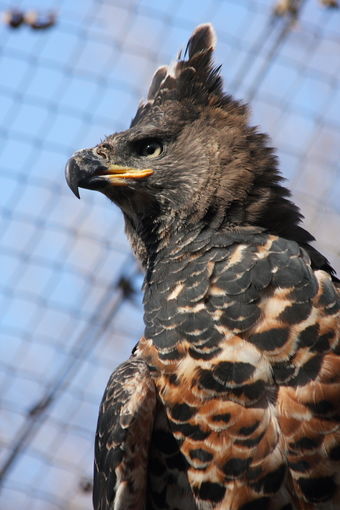Crowned eagles, like all birds of prey, have the ability to voluntarily control their talons and release them at will. There is no involuntary locking mechanism in their talons. This misconception may arise from observations of eagles struggling to release their talons from heavy prey, such as a large fish, while swimming in water. However, eagles can let go of their prey if they wish to do so.
The Anatomy of Crowned Eagle Talons
Crowned eagles have unusually large talons and strong legs, which they use to kill their prey by crushing the skull or causing trauma or asphyxiation. The size and shape of a crowned eagle’s talons are adapted to its hunting strategy and prey handling.
The Hallux Talon
The hallux, or back toe, is the largest and strongest talon, functioning similarly to a thumb in humans, allowing the eagle to grasp and carry its prey with its feet.
The Other Talons
The talons of digits II, III, and IV have supporting roles during hunting and prey handling.
Crowned Eagles’ Hunting Strategies
Crowned eagles are bold and ferocious hunters, primarily targeting mammals and birds in forested habitats. Their hunting strategy involves:
- Still-hunting from a branch perch
- Maneuvering stealthily through the forest
- Delivering a swift and powerful attack, often on the forest floor
Prey Handling and Talon Release
When an eagle grabs a fish that is too heavy to fly with, it may choose to swim to shore, towed by the fish and using its wings to propel itself through the water. In such situations, the eagle may struggle to release its talons from the heavy prey.
However, this does not mean that crowned eagles have an involuntary locking mechanism in their talons. They can voluntarily control their talons and release them at will, even when dealing with heavy or difficult prey.
The Importance of Understanding Talon Mechanics
Accurately understanding the mechanics of a crowned eagle’s talons is crucial for several reasons:
- Conservation: Knowing that crowned eagles can release their talons voluntarily can help inform conservation efforts and dispel misconceptions about their behavior.
- Prey Handling: Understanding how crowned eagles use their talons to capture and handle prey can provide insights into their hunting strategies and adaptations.
- Ecological Relationships: Studying the talon mechanics of crowned eagles can shed light on their role in the broader ecosystem and their interactions with other species.
Conclusion
In summary, crowned eagles do not have involuntarily locking talons. They can voluntarily control their talons and release them at will, even when dealing with heavy or difficult prey. Their large talons and strong legs are adapted for powerful hunting strikes and crushing the skulls of their prey, but they maintain the ability to release their grip when necessary.


